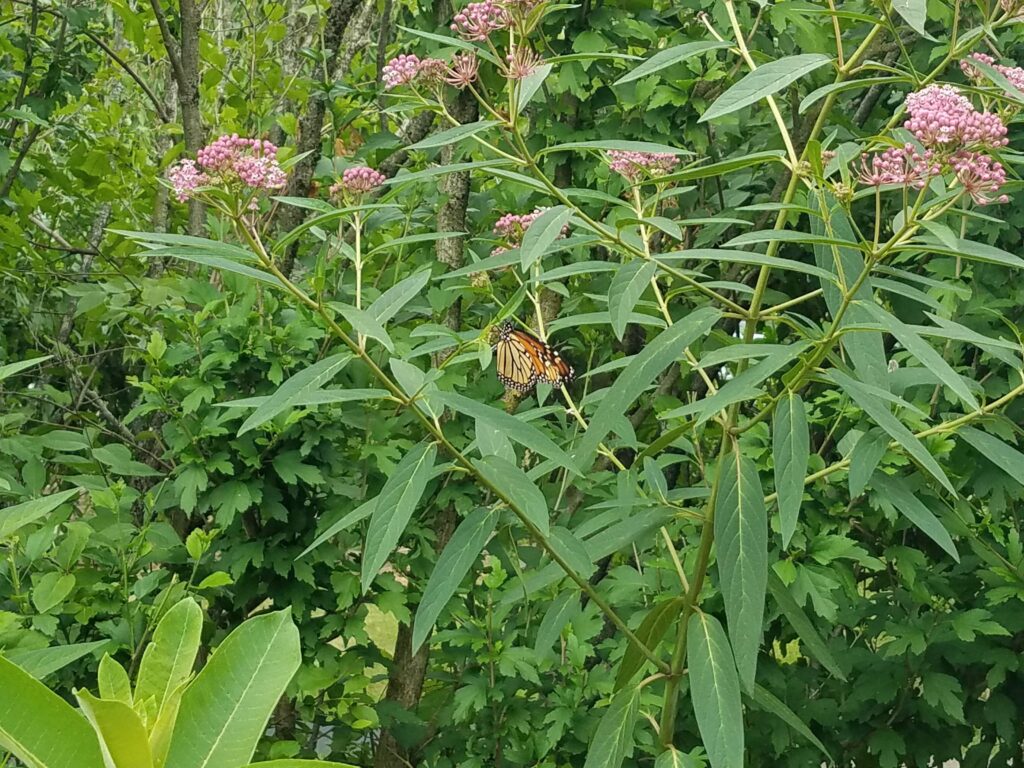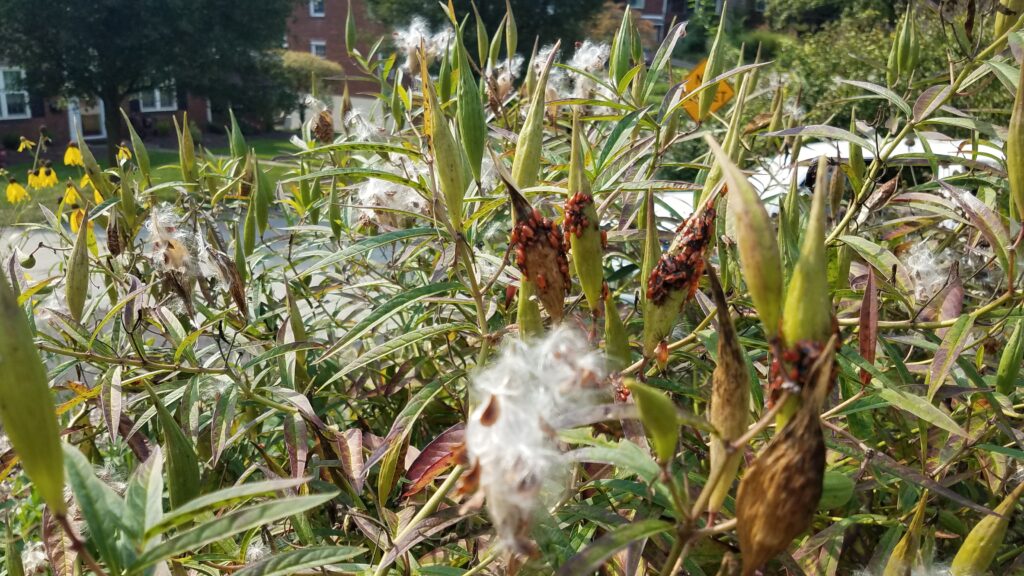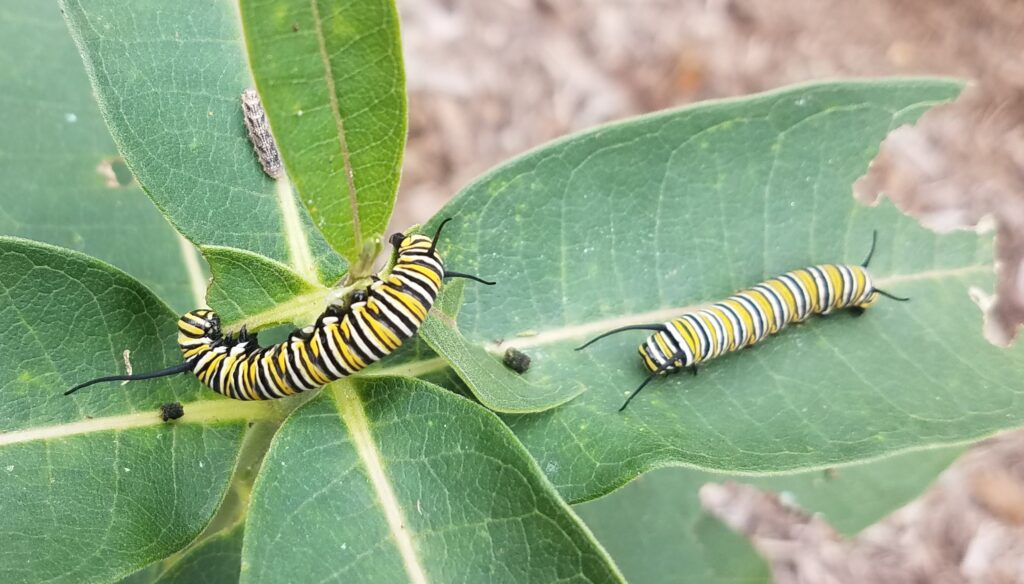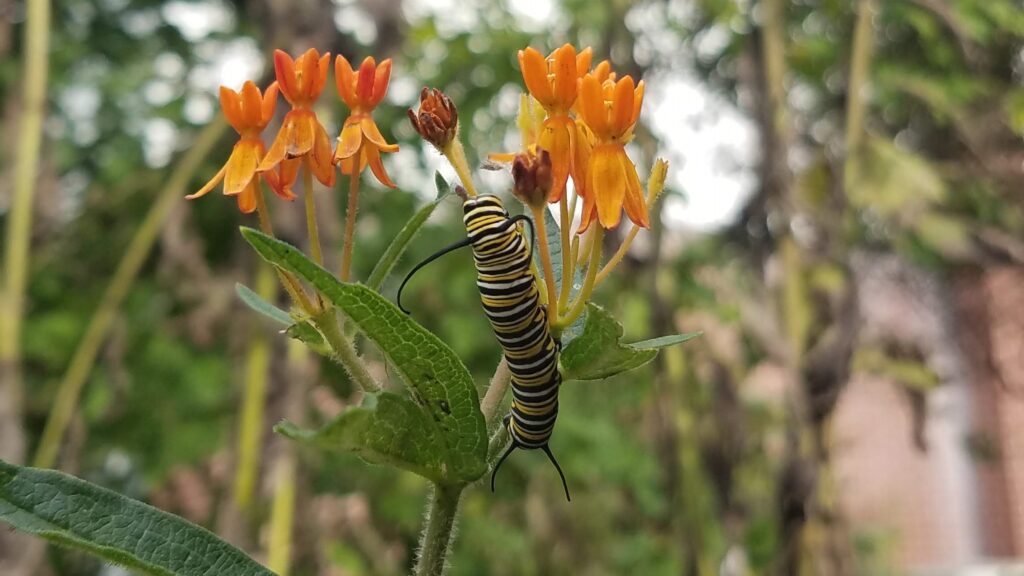When I moved in with Christian six years ago, I almost immediately started thinking about what I wanted to do with the yard from a gardening standpoint. My first thought was of pollinators that needed support, particularly bees. The original plan was to get a bee-friendly garden planted and then get some bee hives after “two or three years.” (My unrealistic sense of time is hilarious.) Now in its fifth year, my garden has expanded to massive proportions,[1] and bees aren’t the only wildlife I want to support. In fact, this year, most of my attention and excitement was concentrated on some other very special guests: Monarchs.

A Long-Expected Party
In 2019 I learned with dismay that not only were my butterfly bushes considered invasive plants, but that they also did not provide the necessary food to support the monarch butterfly lifecycle. While butterfly bushes provide nectar for adult monarchs, only milkweed can provide necessary food for younger stages of life. Once I learned that, I vowed to get some milkweed in the ground the following year to support this dwindling population of beautiful creatures.[2]
Unfortunately, I was a little late buying milkweed seeds in the spring of 2020. (Milkweed was not the only concern on my mind that spring, and getting some plants from my aunt’s garden center on the other side of the state was out of the question.) By the time my seeds arrived, I learned that they still needed to be “stratified” – meaning they needed to believe that they had gone through a winter in the ground. To stratify seeds that you purchase, you can just stick them in the fridge or freezer for a month, but once again, that meant another delay, and it was too late in the season to do anything with them by the time I got around to it.
I managed to get three types of seeds (common milkweed, swamp milkweed, and butterfly weed) into little peat pots in April 2021, but they sat and languished on my porch until July when a monarch visiting my butterfly bushes once again kicked me into gear, and I finally got around to transplanting them in the garden. The seedlings were still incredibly small and unlikely to do much good, though I did find one tiny monarch caterpillar that was sadly gone again after a heavy rain came through.

This year, however, (finally) I had several healthy plants pop up in the yard. I probably put a little too much effort into making sure my milkweed succeeded – it is, after all, a weed and apparently difficult to get rid of once established. But I didn’t want to take any chances that might delay monarch support yet another year, so I made sure that everything was spaced properly and getting sufficient water.
Care and Feeding
The swamp milkweed (Asclepias incarnata) was the most prolific with eight healthy plants returning this spring. Incarnata is the largest of the three types in my yard, at 3-4 feet in height and spread, so these need to be spaced further apart (36 inches between plants). I actually relocated some of them to an expanded patch of garden, and it is safe to do that in spring and fall. Incarnata is the easiest to transplant, as it doesn’t have a long taproot like the others. With its clusters of pink flowers, I think it’s the prettiest of the three that I planted, but sadly the monarchs were least interested in it, and I only found one caterpillar on them all season.
My aunt said her swamp milkweed was a favorite of their aphids. Mine had some aphid activity, but not nearly as much as some of the other plants nearby (like the Heliopsis, which have been aphid magnets the last two years and need some serious assistance from lady beetles and green lacewings [3]). What I did find all over the swamp milkweed was the milkweed bug, a largely harmless insect that is striking in appearance – especially en masse – and feeds on milkweed plants.[4]

The butterfly weed (Asclepias tuberosa) is the smallest, generally 1-2 feet tall with small, thin leaves and clusters of orange flowers. I think these are beautiful too, but given their size and shape are more susceptible to root rot if the soil does not have sufficient drainage. They can be planted about 18 inches from each other, but since they have a deep taproot (which can be as long as 18 inches), you may be stuck with them wherever you put them. Attempts to transplant these should be done in the spring or fall, using a long, narrow, transplant spade to get as much of the taproot as possible.[5] The three plants that came up this year hosted about four caterpillars.
About five common milkweed (Asclepias syriaca) plants came up this year but were small and did not flower. I’m hoping that’s just a factor of age, and that we will see their pink-and-white, pom-pom-shaped flower clusters on 3-foot tall plants next year. In all honesty, they are my least favorite in appearance, but they were by far the most popular among the caterpillars. I always found two or three big, fat monarch caterpillars chowing down on the broad leaves of this plant. Like tuberosa, syriaca can be spaced about 18 inches apart and has a deep taproot. I hope to move some of them into some of my new garden areas, but since they didn’t flower this year, it will have to be a successful transplant or else I’ll have to start from seed again. Young plants in their first few years are the easiest to move, so I will probably try with a few this fall and a few more in the spring.
Syriaca came up in two separate places in the yard, and the much bigger plants (where there would have been less competition for food) were ignored. I don’t know if that was a factor of actual location preference or just a factor of where the adult females laid their eggs. Either way, these plants were utterly consumed by the time the caterpillars left them to go pupate. I experienced pure joy going out to look at them every morning, to watch them munching away on the leaves and growing over time. They all vanished on the same day, which made me sad, but I wish them success in their next stage of life.

Monarch Lifecycle
Adult monarch butterflies lay eggs on milkweed plants, which will hatch after 4-6 days. The average female will lay 300-500 eggs in a 2-5 week period. Once the egg hatches into a larva (or caterpillar), it will spend the next 2-3 weeks eating and growing. Caterpillars shed their skin as they grow through five distinct stages until they are ready to pupate. They will find a safe place to spend the next 5-15 days in the chrysalis before emerging as an adult and repeating the cycle. Most adults live 2-5 weeks, but those born in late summer or early fall will live for several months as they migrate south to Mexico.[6]
When mine all vanished on the same day, I was nervous, thinking that either some predator had come through and picked them all off at once or that there wasn’t enough food on the tiny but popular plant, which led to a mass exodus – they are known to get hangry when there isn’t enough milkweed.[7] I couldn’t find a single chrysalis nearby, which made me even more nervous that something had happened to them, but it turns out that monarch caterpillars can travel as far as 10 meters to find a safe space to pupate! What that means for me is that I have a legitimate reason to hold off on any hedge trimming for at least two weeks.
Given the timing, I doubt this last generation of monarchs for the year will stick around for too long after emerging since they will need to be heading south. I am glad that my (invasive) butterfly bush is still going strong, and that my new asters and goldenrod are blooming, so that the new adults will have some food for the road.

Do you have milkweed in your yard? Have you been able to watch any monarchs grow through various stages, either in the wild or in a more sheltered environment? I’d love to hear about it in the comments.
Thanks for reading!
[1] https://radicalmoderate.online/pollinator-garden-update-2022/
[2] https://radicalmoderate.online/monarch-101/
[3] https://radicalmoderate.online/insect-warfare-aphids/
[4] https://www.gardeningknowhow.com/ornamental/flowers/milkweed/milkweed-bug-control.htm
[5] https://monarchbutterflygarden.net/how-to-successfully-transplant-milkweed-taproots/
[6] https://www.butterfliesathome.com/monarch-butterfly.htm
0 Comments